#David M. Schwartz Architects
Explore tagged Tumblr posts
Text
Best trad buildings of 2022
Best trad buildings of 2022
Capital Square, in Richmond, with the original Life Insurance Co. of Virginia under construction to next to city hall to the center left of the Virginia State Capitol, designed by Thomas Jefferson. It grows ever more difficult and hence ever more depressing to construct these annual roundups of traditional architecture. I feel a bit of guilt arising from the headline “Best trad buildings of…

View On WordPress
#David M. Schwartz Architects#Estudio Urbana#Glave & Holmes Architects#Joseph Jutras#Michael Diamant#Perkins & Eastman Architects#Robert A.M. Stern Architects
0 notes
Text
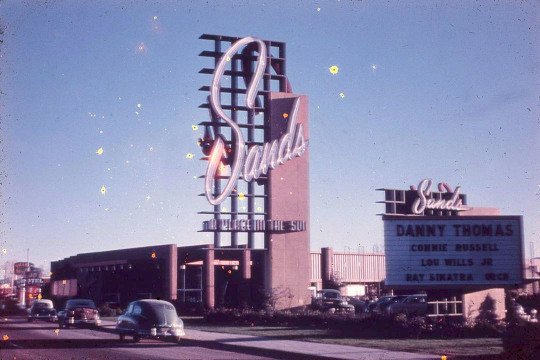
Sands Hotel & Casino '52-'96
Sands, December 1952
Kit Carson Club ('46-'50) Kit Carson Motel ('46-'63) La Lue nightclub ('50-'51)
'46: Kit Carson Club opened by H. Bynum, D. Anderson, G. Frisbee on US Hwy 91 outside of Las Vegas, adjacent to Kit Carson Motel. The club will later become LaRue nightclub, then the Garden Room of the Sands Hotel.
'50: Kit Carson Club reopened as LaRue nightclub opened by Billy Wilkerson, Nola Hahn, 12/23/50.
'51: LaRue closed by summer. Mack Kufferman buys LaRue, and hires architect Wayne McAllister to build around the existing club. Kuffman and partners apply for gaming license. The project is called Sands by 12/51.
Sands ('52-'96)
'52: Kufferman gaming license denied in Apr., sells to Jake Freedman (RG 4/9/52, RG 6/13/52). Partners running the Sands are B. Barron, E. Levinson (casino manager), S. Wyman, J. Entratter (showroom & restaurants). Hidden partners are believed to include J. Stacher, M. Lansky. Sands road sign designed by McAllister, built by YESCO. Sands opens 12/15/52 with 200 rooms in five buildings arranged in Y-shaped layout. The guest wings are named after race tracks: Arlington Park, Belmont Park, Haileah, Rockingham Park, Santa Anita. Three other wings of equal size were added circa ’53-54 (two were named Churchill Downs, Hollywood Park), another by ’58, and larger wing by ’60. The total room count in ’60 was 465.
'53: Frank Sinatra plays his first engagement at the Sands and becomes two percent owner in Oct; Carl Cohen joins the Sands as shareholder and casino manager in Oct.
'54: Sign modification: Second reader board added below the main board, Feb or earlier. Antonio Morelli joins the Sands as musical director for the Copa in Jul.
'55: Sands partners assume control of the Dunes in Sep. They sell the Dunes in four months later.
'58: Jake Freedman dies 1/19/58; Jack Entratter becomes Sands president.
'59: Sign modification: Attraction board attached to the sign, Feb or earlier. Baccarat begins at the Sands. Sands acquires the former Orinda Motel, property to the south, used for expansion of the Sands parking lot.
'60: Sinatra, Dean Martin, Sammy Davis Jr, Peter Lawford, and Joey Bishop (the "Rat Pack") are first billed together in the Copa in Jan-Feb. during the filming of Ocean's 11. Senator John F. Kennedy visits during the Democratic primary campaign.
'63: Opening of Aqueduct hotel wing (83 rm) in Apr. Julius Gabrielle, architect (RJ 4/28/63). Sinatra surrenders ownership 10/7/63.
'64: Sands acquires the former Kit Carson Motel; Belmont and Arlington buildings (base of the Y) moved southward to accommodate construction of a hotel tower.
'65: Second sign in Aug; tower completed late in the year and officially opened Jan. ’66. Martin Stern Jr, architect.
'67: Howard Hughes buys the Sands, 7/23/67. Sinatra leaves his Sands residency after confrontation with Cohen, 9/11/67.
'69: Dean Martin leaves Sands to join Riviera.
'71: Entratter dies, 3/8/71.
'73: Cohen leaves the Sands, Jan. '73.
'80: Inns of America buys the Sands from Hughes heirs Summa Corp in Oct.
'82: Third sign, new porte-cochère, marking the completion of remodeling effort including new Copa room, 1/15/82.
'83: Summa Corp reassumes control of the Sands, 4/5/83.
'88: Kirk Kerkorian buys the Sands in Jan. Kerkorian sells to Interface Group led by Sheldon Addison in Apr.
'90: Sands Expo and Convention Center opens.
'94: Remodeling of the casino.
'96: Sands closes 6/30/96. Tower demolished 11/26/96.
Photos of the Sands
Sources include David G. Schwartz. At the Sands: The Casino That Shaped Classic Las Vegas, Brought the Rat Pack Together, and Went Out With a Bang. December 1952 photo courtesy of Slidetreasurehunt.
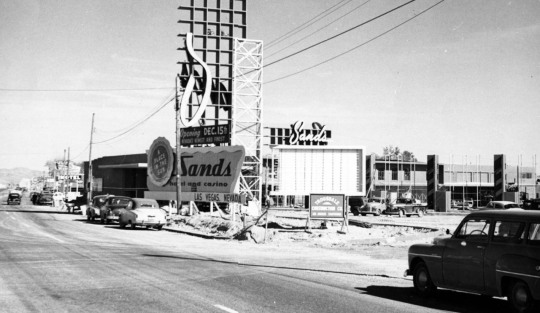


Construction of the sign, 1952. The pylon sign pedestal was 56’ high, 21’ wide, with the S at 34’ tall. Design by Wayne McAllister, fabricated and installed by Young Electric Sign Co. Photo: YESCO Corporate Records (MS-00403), UNLV Special Collections & Archives.
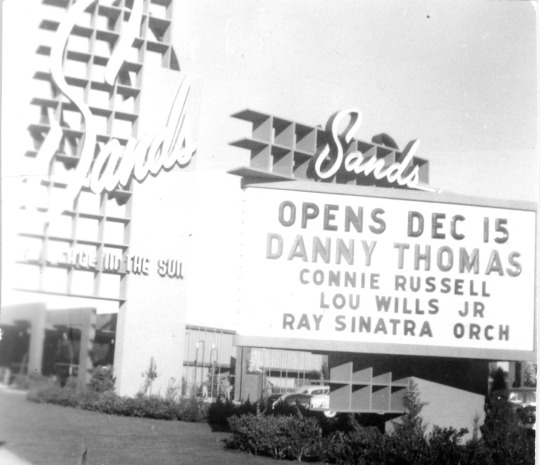
Opens Dec 15. Danny Thomas, Connie Rusell, Lou Wills Jr, Ray Sinatra Orchestra. Nevada State Museum, Las Vegas, 0007-0345.

Aerial view of Kit Carson Motel and the Sands, '62
55 notes
·
View notes
Text
The McMansion Hell Big List of Books, Websites, and Films about Architecture
SURPRISE!!!!
Edit: I had to take out the “Read More” tab because it killed all of my links, so Sorry for the long post!
Hello Friends! I feel as if I haven’t really been giving back to the community as much I should be in these last few weeks, and that while my latest Sunday posts have been mildly amusing, nobody is really learning anything from them.
I shared some recommended reading on my Facebook page a week or so ago, and want to expand on that list here. Architecture is a wonderfully rich field with a plethora of resources. This post is a master-list of the architecture books, blogs, websites and films I have accumulated since my early teens.
While extensive, this is in no way a definitive list, and I’m sure many others will have quite a bit to add on in the comments. I hope you enjoy!
Books
Links are to Amazon. A ** next to the title indicates the link is to an open-source copy of the book, or that it is easily available online.
General Architecture (non-academic, general interest)
Paul Goldberger, Why Architecture Matters
Alain de Botton, The Architecture of Happiness
Witold Rybczynski:
Looking Around
How Architecture Works
Home
Matthys Levy/Mario Salvadori, Why Buildings Fall Down**
Mario Salvadori, Why Buildings Stand Up**
Stewart Brand, How Buildings Learn
Tom Wolfe, From Bauhaus to Our House**
Christopher Alexander, A Pattern Language**
Bill Bryson, At Home
Matthew Frederick - 101 Things I Learned in Architecture School
Architectural Style (Field Guides)
Virginia McAlester, A Field Guide to American Houses
If you want to buy one book on this list, I highly recommend this one. It’s the best book out there about American residential architecture. If you’re curious about houses, it’ll sate your curiosity.
Carol Davidson Cragoe, How to Read Buildings: A Crash Course in Architectural Styles (this one is neat for traveling about because it’s small)
John J. G. Blumenson, Identifying American Architecture: A Pictorial Guide to Styles and Terms, 1600-1945 (an old but good small guide)
Nikolaus Pevsner, An Outline of European Architecture**
Pevsner Architectural Guides: Introductions [Houses • Churches]
Richard Apperly, A Pictorial Guide to Identifying Australian Architecture: Styles and Terms from 1788 to the Present
Cities, Suburbs, and Housing (of course not a complete list)
Jane Jacobs:
The Death and Life of Great American Cities
The Economy of Cities
Cities and the Wealth of Nations
Vital Little Plans: The Short Writings of Jane Jacobs
Kevin Lynch, The Image of the City **
Lewis Mumford: The City in History
Aldo Rossi: The Architecture of the City**
Ebenezer Howard, Garden Cities of Tomorrow
Witold Rybczynski:
Mysteries of the Mall
City Life
Makeshift Metropolis: Ideas About Cities
Kenneth T Jackson, Crabgrass Frontier: The Suburbanization of the United States
Joel Garreau, Edge City: Life on the New Frontier
James Howard Kunstler:
The Geography of Nowhere
Home from Nowhere
Dolores Hayden, PhD:
Redesigning the American Dream: The Future of Housing, Work and Family Life
A Field Guide to Sprawl
Building Suburbia
Andres Duany, Elizabeth Plater-Zyberk, Jeff Speck: Suburban Nation
It’s only fair to put the New Urbanists in here.
John Archer, Architecture and Suburbia (a favorite reference of mine)
Tracy Kidder, House
Sarah Susanka, The Not So Big House
Peter Marcuse & David Madden, In Defense of Housing
Matthew Desmond, Evicted
Alex F. Schwartz: Housing Policy in the United States
Architectural History:
Spiro Kostof, A History of Architecture: Settings and Rituals (personal favorite)
Francis Ching, et. al. A Global History of Architecture (a standard college textbook)
Carol Strickland, The Annotated Arch: A Crash Course in Architectural History (a lot of fun!)
Daniel Borden, et al. Architecture: A World History
Leland M. Roth & Amanda C. Clark, American Architecture: A History
William J. R. Curtis: Modern Architecture Since 1900 (a classic)
Edward R. Ford, The Details of Modern Architecture
Kenneth Frampton, Modern Architecture: A Critical History**
Heinrich Klotz, The History of Postmodern Architecture
Charles Jencks, The Story of Postmodernism
Architectural Theory & Criticism Essentials
General Architectural Theory:
Leland Roth, et al. Understanding Architecture: Its Elements, History, and Meaning
Francis Ching, Architecture: Form, Space, and Order** (AKA freshman year of architecture school)
Siegfried Gideon, Space, Time, & Architecture
Gaston Bachelard, The Poetics of Space **
Roger H Clark & Michael Pause, Precedents in Architecture**
Mark Foster Gage, Aesthetic Theory: Essential Texts for Architecture & Design
Geoffrey Scott: The Architecture of Humanism: A Study in the History of Taste **
M. Fil Hearn, Ideas that Shaped Buildings** (a great handbook of architectural theory through history - always by my side.)
Lewis Tsurmaki Lewis, Manual of Section (not quite architectural theory, but a super cool book)
Alexandra Lange, Writing About Architecture - not quite theory but a v good and useful book.
Kate’s Top 4 Very Old Dead Guys (all public domain)
Vitruvius, The Ten Books of Architecture
Andrea Palladio, The Four Books of Architecture
Leon Battista Alberti, The Ten Books of Architecture
John Ruskin, The Seven Lamps of Architecture
Modern Architecture
Adolf Loos, Ornament & Crime **(fake summary below):
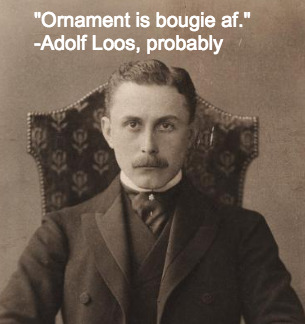
Le Corbusier, Towards a New Architecture**
Henry Russell Hitchcock & Philip Johnson, The International Style **
Reyner Banham, Theory and Design in the First Machine Age**
Ulrich Conrads, Programs and Manifestos on 20th Century Architecture**
Kenneth Frampton, A Genealogy of Modern Architecture
Ada Louise Huxtable, On Architecture: Reflections on a Century of Change
Current Architectural Theory / Contemporary Classics
Vincent Scully
Architecture: The Natural and the Manmade
American Architecture and Urbanism
Modern Architecture
The Shingle Style Today (this book completely blew my mind in high school, and remains one of my favorite books about architecture to this day.)
Robert Venturi + Denise Scott Brown
Complexity and Contradiction in Architecture**
Learning from Las Vegas**
Rem Koolhaas:
S,M,L,XL
Delirious New York**
Peter Zumthor:
Atmospheres
Thinking Architecture
Bernard Tschumi, Architecture & Disjunction**
Junichiro Tanizaki, In Praise of Shadows **
Films
Most of these films have the full version online for free. I won’t link directly to them because I don’t want to get yelled at.
Films About Architects:
My Architect [film about Louis Kahn]
Regular or Super: Views on Mies van der Rohe
Rem Koolhaas: A Kind of Architect
Sketches of Frank Gehry
Frank Lloyd Wright (Ken Burns)
First Person Singular: I.M. Pei
Eames: The Architect & The Painter
Louis Sullivan: The Struggle for American Architecture
Infinite Space: The Architecture of John Lautner
How Much Does Your Building Weigh, Mr. Foster?
Loos Ornamental
Films about Architecture:
Kochuu [film about contemporary Japanese architecture]
The Pruitt-Igoe Myth [about the Pruitt-Igoe housing complex in St. Louis]
Unfinished Spaces [About Cuba’s National Art Schools Project]
Urbanized [about the design of cities]
Visual Acoustics [about the photographer Julius Shulman]
Great Expectations [general architecture]
I’d like to make a shoutout to my colleague Thomas Bena, whose film about McMansions, One Big Home, is making the film circuit now. I’ve seen the movie and will be writing a review on this blog in the coming weeks. In short: go see it if you can!!!
Websites
Architecture News / Popular Websites:
Curbed
Dwell
Dezeen
ArchDaily
Architizer
Wallpaper*
FastCo Design
CityLab
Architonic
Domus
Archinect
Inhabitat
Blogs:
Life of an Architect
Life of an Architecture Student
Build Blog
Soapbox Architect
My Favorite Websites:
99 Percent Invisible (disclaimer: I write for them)
Archinform - an online encyclopedia of architecture
Monoskop - a huge database of amazing archival resources for architecture and design.
Arts & Architecture database
US Modernist Magazine Library - incredible collection of primary sources from modernism
Docomomo (preservation of modernist architecture)
Failed Architecture (analyzing failure in architecture)
Places Journal (my favorite online journal)
Emporis (it has every tall building!)
On Tumblr
Tumblr seems to have killed my links. This is devastating.
Like McMansion Hell:
@uglybelgianhouses - the best, really the best. @terriblerealestateagentphotos
General Architecture: @architecture-drawings @archidrawings @archatlas @archidose @archimaps @archiclassic @architecturalmodels @an-architectural-statement @conceptarchitect @rationalistarchitecture @wherearchitectureisfun @archivemodernarchitecture @luciotuzza @drawingarchitecture @dailybungalow @victorianhouses @ofhouses @architorturedsouls
Modern Architecture: @20cmodern @fuckyeahbrutalism @architectureofdoom @modernism-in-metroland @theimportanceofbeingmodernist @modernistestates @germanpostwarmodern @decoarchitecture @englishmodernism @midcenturymodernhomes @bauhaus-movement @artfuckingdeco @iheartnouveau @sosbrutalism @americanmodern
Postmodernism: @aqqindex @palmandlaser (these two blogs were why I got a tumblr) @memphis-milano @80sdeco @blockygraphics @thetriumphofpostmodernism
Vintage Stuff: @midcenturymoderndesign - mid century modernism @scanzen - an assortment of cool stuff @midcenturyblog - mid century stuff @superseventies - 70s @cardboardamerica -vintage postcards @theswinginsixties - 60s @70sscifiart - 70s Sci Fi Art @driveintheaterofthemind - great vintage blog @80stechnology - 80s tech @imperialgoogie - the 50s @ephemera-phile - old print stuff from various eras @heck-yeah-old-tech - old technology @quadrafonica - vintage hifi @homophoni - also vintage hifi @holespoles - all kinds of stuff @system32dreams - 80s/90s tech @monochrome-monitor - 80s/90s tech @beautifulcentury - 1890s-1910s @oldadvertising - vintage ads @back-then - amazing photographs from history @fifties-sixties-everyday-life - 50s/60s @y2kaestheticinstitute - turn of the 21st century @lpcoverlover - record covers @classical-vinyl - my first tumblr (I comment as classical-vinyl, fyi)
Favorite Architecture Photographers:
@phdonohue @archivemodernarchitecture @archivemoderninteriors @veronicadelica @new-brutalism @wmud
Design/Art/People Who Consistently Post Awesome Things: @archiveofaffinities @zeroing @design-is-fine (one of my favs ever) @c86 @norequeststaken @scavengedluxury (another fav) @99percentinvisible @magictransistor @transistoradio @klappersacks @designstroy @ffactory @instereo007 @contac @publicdomainreview @detailsofpaintings @modernizor @nemfrog @bluecote @graphicgraphic
Visual Artists I Like: @sunday-thought @jimharrisart @jacobvanloon @michaelwardartist
Also shoutout to @maverick-ornithography who is not only hilarious, but who was also my first ever follower, so now I’m returning the favor.
I hope you all enjoyed this post! Next up is Florida on Wednesday, so stay tuned! I’ll finish up Great Britain after that; I’m currently reading books on British vernacular architecture and its history so I’m more informed. I barely dodged some bullets in that last post and had to go back and correct a lot…
Have a great week!
If you like this post, and want to see more like it, consider supporting me on Patreon! Tonight, I’m doing a live Discord chat with my $5+ Patrons at 8:30PM EST!
Not into recurring donations? Check out the McMansion Hell Store - 30% goes to charity.
2K notes
·
View notes
Text
Our Favourite Movies by the 2017 Sundance Film Festival
Sundance this year was full of virtual reality, protest marches, and times and times (and times) of snow. But you watch a whole lot of movies, while you visit a movie festival, and we watched an eclectic collection of names across genres and all types. Dramas set from stories of an Brooklyn invasion, the Deep South, also among the strangest supernatural movies ever made… there was a whole lot to consider in. Below are our favorite movies from this season’s Sundance Film Festival.
Andrew Droz Palermo / Sundance Institute
A Ghost Story
As soon as I walked into David Lowery’s A Ghost Story, I had no idea what to expect. I understood it was taken in secret; I understood that it showcased Rooney Mara; also I understood Casey Affleck played with a character who shows up as a ghost dressed in a white sheet and dies. I discovered that it was beautifully shot and fascinating after the film began. I then discovered it to be using a wordless scene that stretched on for a minimum of 10 minutes. I then discovered it for a pretty ingenious source narrative about a poltergeist haunting. And then, following the film had gotten more bizarre, stranger, more and more evocative than I could have ever anticipated, I recognized that it was a beautiful ode to loneliness, loss, along with the fierce courage it takes for us faulty human beings to accept fate and move on when disaster strikes.
Walking out of the theatre then, I wouldn’t’ve said I enjoyed it. But from the days I awakened that I & rsquo; m pretty certain was inspired by the movie, as well as & rsquo; t talked with coworkers returned to its beauty in my mind. A Ghost Story has stuck with me in the most rare and rare of manners, and the most impressive thing about the movie is that each time I think back into it, I discover some new component to enjoy. –Bryan Bishop
Christian Sprenger / Sundance Institute
Brigsby Bear
I’t composed about this one already, so I won’t go into much detail here, except to say that this winning comedy, starring Saturday Night Live’s Kyle Mooney, completely surprised me. I’d see a description and I believed I understood what it was about — doofus loves kids’ TV series and so is obsessed with re-creating it — before the film started. And I wondered when I had the picture, because I was enjoying the discovery process, however I didn & rsquo; t care. This is among these debuts that makes people think “I have to keep your eye on this group longterm and find out where they go out of here. ” Director Dave McCary and co-writer Kevin Costello (who scripted with Mooney) have been friends since childhood, and this feels like the kind of job the founders have been working on a long time — long enough to tweak each part of the narrative until it hums. –Tasha Robinson
Sundance Film Festival
Bushwick
I watched one picture — as in 1 flat-screen, feature-length film. It was called Bushwick, also it was similar to the last iteration of the current“Should you punch Nazis? ” debate, except it was & ldquo; Should you get if you’re a student with neo-Confederates who’ve invaded Brooklyn into a guerrilla warfare along with an ex-Marine played with Dave Bautista? ” (The response: “Possibly? ”-RRB- Long story short: my search results are now full of & “brooklyn militia” & &;ldquo;rifle permit laws nyc” also I think possibly I took the wrong message out of this picture.
Luckily, I additionally watched almost every single digital reality experience at Sundance, also wrote up a guide to the finest of this festival earlier this week. It features Dear Angelica, also a movie about fiction and death written as a dreamy three-dimensional painting; Life of Us, also a lively two-person travel through the development of life on Earth; along with Mindshow, also a theatre where you act out the role of each character, and then loop them all together to tell a tale. VR still hasn’t come into its own quite yet, however there was a whole lot to appreciate about 2017’s slate, and hopefully it will be accessible to everybody by the end of the year. —Adi Robertson
Sundance Institute
Phone Me From Your Name
I hadn’t see Phone Me From Your Title before I watched the movie adaptation by director Luca Guadagnino (A Bigger Splash, I’m Love). I was surprised to listen to the publication, composed by André Aciman, was published in 2007. The narrative of a 17-year-old American-Italian boy decreasing for the 24-year-old man seeing with his parents’ Italian summer house has a classic’s richness, sincerity, and maturity. I suppose that the 1980s setting — the ample chest hair, that the slang, the group tees — ought to have given it off.
This is a pure love movie, which is to say, unlike much of Egyptian dramas about homosexual relationships, Phone Me From Your Title doesn’t quickly morph into a tragic drama where the pair battles a bigoted outside drive, or conceal their affair from an homophobic public. It’s an immediate and profoundly upsetting story of summer love, performed with Timothée Chalamet and Armie Hammer using a chemistry that’s pretty magnificent. The picture is hot mature, andfeatures songs out of Sufjan Stevens. Decades from now, I believe this movie will be described by film critics for what it is: a classic. –Chris Plante
Elisha Christian / Sundance Institute
Columbus
Back in 2014 we praised Kogonada’s video experiments that analyze the visual structure and fashion of iconic movies. Columbus marks the manager’s transition from singer to incorporate filmmaker. Its title refers to Columbus, Indiana, a Midwest city that’s house to a wealth of contemporary architecture, a couple of factories, along with a defeated young girl named Casey (Haley Lu Richardson). Putting off college to care for her in-recovery mum, Casey spends practicing her tour guide regular and shelving books at a library.
This is a coming-of-age movie, so that the crowd has a general idea of where most of this is moving — who’s hospitalized and on the cusp of passing — when Casey meets a 24-year-old translator seeing his architect dad, Jin. But the characters bond, learn from one another, also specify a path into the near future is modest and sincereso. There isn& rsquo; t a treacly soundtrack of a plot spin that is revelatory and also pop , two wounded individuals gradually revealing themselves. The movie makes a case for architecture’s healing properties, but might equally well be speaking to movie. Columbus is a feel-good film, as it takes our ordinary anxieties and, scene by scene, so soothes them. –Chris Plante
Jojo Whilden / Sundance Institute
Landline
Landline is Gillian Robespierre’s follow-up into the amazing 2014 dramedy Obvious Child. Just like its predecessor, it celebrities this time as Dana, Jenny Slate, also a 20-something with a quarter-life catastrophe in mid-and -lsquo;90s New York City. Robespierre has an eye for the moments that build a life rsquo & the movieplay about infidelity plays out in miniature, moments that are recognizable, like a vague memory of something from your own childhood.
The title refers to the phones of the era, which onto kitchen walls were wrapped at the time. This point for technology in our life is a character unto itself. Slate’s suspicions regarding her dad stem from a set of poems discovered on a floppy disc. Characters aren’t have to check in by feeding turn right into a telephone booth, and reachable from relations that are omnipresent. These particulars highlight things change as occurs with powerful time pieces, however, people remain the same. –Chris Plante
Steve Dietl / Sundance Institute
Mudbound
Occasionally a festival crowd hits and the standing ovation and the minute that the credits roll begins, you are aware that you’t seen something particular. This was the experience I’ve had watching Dee Rees’Mudbound, a rough and moving tale of two families in racially divided Mississippi. Set during World War II, the movie stars Jason Clarke and Carey Mulligan as Henry and Laura McAllan, who have lately jumped into a farm they’ve. Sharecropping on the exact same territory are Hap and Florence Jackson (a great Rob Morgan and Mary J. Blige), who are trying to carve out their own little independence — while also coping with constant guilt and racism, frequently from Henry’s dad (Breaking Bad’s Jonathan Banks).
What sets the movie apart is the way that it investigates the wartime adventures of Henry’so brother, also a swaggering Garrett Hedlund, and Hap’s kid, Ronsel (Jason Mitchell). Both characters wind up working in World War II, which gives them the opportunity to step outside the pervasive and systemic class. When they return, they wind up forming a bond — not just because they’re both suffering from the trauma of warfare, but because they feel trapped at system and a country of beliefs that have come to be untenable. The fact that Rees is able to finish her story despite some of the horrors that the characters endure, make it essential viewing. –Bryan Bishop
Andrei Bowden Schwartz / Sundance Institute
The Polka King
The Polka King is just one of the based-on-a-true-story movies that shut with news and footage clips in the real-world events, not for that the usual sentimental or manipulative reasons, however as it’s most probably that few individuals would believe the story was true without onscreen evidence. Jack Black stars as Jan Lewan, an upbeat Polish soldier that builds a polka band, begins a tchotchke shop, marries former small-time beauty queen Marla (Obvious Child’therefore Jenny Slate), also works odd jobs, trying to collect the money to create himself a small empire. He’s got large dreams that his small American earnings may’t match, so in the process, unwittingly, promising high returns — and he begins soliciting investments out of his lovers creating a Ponzi scheme that is doomed.
Many of the details that are more unlikely are true, however Black & rsquo; so large, flashy performance, complete with English, bizarre accent, along with polka numbers, lays this squarely in the domain of humor. The Polka King has a lot in common with Bernie, Richard Linklater’s true-life narrative about a beloved Texas mortician (also played by Black) who murders his possessive benefactor and shoves her in the freezer. Both movies are dark hit stories regarding fixtures that are local that are cheery who betray their friends, but encounter as scamps. But Polka King is broader, more manic, and more ridiculous, and it’s consistently great fun. –Tasha Robinson
Gilles Mingasson / Sundance Institute
78/52
The first time that I watched Alfred Hitchcock’therefore Psycho,it was on a VHS cassette I’d rented from the regional public library (oh, the excellent old times). It was outdated by modern standards then, but the movie; t stop from leaving an impression. The image of Anthony Perkins looking directly into the camera lens in the film’s final moments was what stuck with mepersonally, but the spectacle that set up that terror in the first place was that the film’s shower chain.
This shot from Alexandre Philippe (The People vs. George Lucas) takes its name from the 78 camera setups and 52 cuts used to create the scene, also brings together directors, editors, critics, and Hitchcock scholars to break down it. They talk the cultural climate at the moment, what taboos were being broken, and how this 1 sequence utterly changed the way movies were assembled. This isn’t a movie. It sputters out with no definitive ending, and the larger issue of rsquo & Hitchcockrepresentation of girls in his movies is left unaffected — something that feels to be an oversight. But 78/52 nevertheless pushed all of my film school programs, and reminded me why a picture made nearly 60 years ago is still so important. –Bryan Bishop
Gilles Mingasson / Sundance Institute
To The Bone
Buffy The Vampire Slayer’s Marti Noxon heavily based her directorial debut on her own teenage experiences with anorexia, and it shows in the details. It isn“ rexy & rdquo & rsquo; t only the educated, intimate details concerning tricks like food and spitting it out. It isn’t only the realism of this pride anorexics feel at maintaining even the interpersonal bonds, or control they form around encouraging each other through the illness. It’s in the honest yet sympathetically created characters. It’d be easy for a picture on this topic to sense like an afterschool special, however Noxon makes it feel important by making it tough and uncompromising, and evoking what Pop feels like from the inside just as much as what it looks like in the outside.
Lily Collins gives a totally amazing performance as 20-year-old anorexic Ellen, who’s attaining a crucial point of meltdown because she builds a cynical wall around herself, refusing to cooperate with therapy, regardless of the way her half-sister Kelly (Liana Liberato, too excellent) cajoles her, or her delicate stepmother Susan (Carrie Preston) pushes her. So many standard things happen in this picture — Susan gets Ellen into a program with an unconventional, rules-challenging physician (Keanu Reeves, the movie’s just horizontal view); Ellen meets a wryly funny recovering-anorexic boy (Alex Sharp) and begins a tentative love; Ellen has a devastating family-therapy session at which the origins of her anxiety and anger are shown. But Noxon requires none of those threads from the tap directions. Instead, she makes it very clear that Ellen can&rsquo. She must do it herself. at Sundance, so audiences should be in a position to discover how well she handles that goal soon enough. —Tasha Robinson
from droidsandewoks http://www.droidsandewoks.com/our-favourite-movies-by-the-2017-sundance-film-festival/
0 notes
Photo



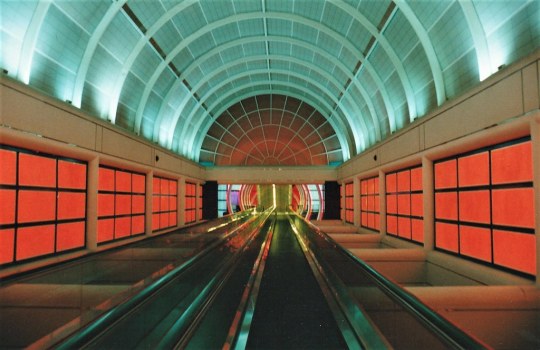
Entrance to Bally’s, 1994
Architect Brad Friedmutter designed an entranceway to Bally’s that replaced the former parking lot and porte-cochère with a water & light attraction which was planned to lure pedestrians to Bally’s casino at a time when the they relied solely on its hotel guests. A 300-foot moving walkway took visitors “between two aqueducts of dancing waters, fog, and pulsating lights.” It opened July 1994.
Visibility of this entrance was later obscured by the construction of the pedestrian bridge over Las Vegas Blvd (’99), the bridge over Flamingo Rd (’00), and Bally’s new 150-foot sign (’01). The walkway was replaced by Grand Bazaar Shops in the 2010s.
Photos: (1,2) undated postcards, (3,4) by JA, ’96. J. Edwards. “Bally’s to jazz up lot with water attraction,” Review-Journal, 5/7/93; M. Pledger. “Strip monorail under way,” RJ 8/26/94; Brad Friedmutter, interview by David Schwartz, 9/12/2016, Oral History Research Center at UNLV.
120 notes
·
View notes